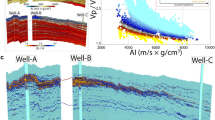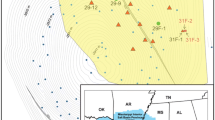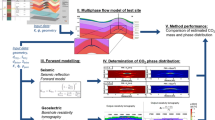Abstract
Geological storage of \(\hbox {CO}_{2}\) in mature sedimentary basins and deep saline water aquifer requires special considerations on the potential leakage pathways. Early detection of \(\hbox {CO}_{2}\) leakage from geological storage is one of the primary objectives of any carbon capture and storage technique. Thermodynamic properties of injected \(\hbox {CO}_{2}\) and formation fluid, and change in in-situ conditions may act as driving agent to \(\hbox {CO}_{2}\) leakage. Therefore, it is important to monitor the saturation of \(\hbox {CO}_{2}\) and identify the phase of \(\hbox {CO}_{2}\) during the injection, storage and after storage stages in order to monitor its possible migration and leakage risks. Seismic monitoring of sequestrated \(\hbox {CO}_{2}\) in subsurface is in practice in which Gassmann fluid substitution model is used to estimate porous rock and pore fluid properties. The seismic properties of \(\hbox {CO}_{2}\) contaminated fluids are predicted by Wood’s volume average formula. The analysis reveals that Wood’s approach is unable to account properly the properties of fluid mixture especially near bubble point pressure of \(\hbox {CO}_{2}\)/water mixture, thus unable to monitor primary leakage of \(\hbox {CO}_{2}\). A modified approach based on thermodynamics is adopted for the detection of primary leakage of \(\hbox {CO}_{2}\). The analysis shows that for a minute amount of free \(\hbox {CO}_{2}\), the P-wave velocity is much lower than the values predicted by the Gassmann-Wood approach. The resulting normal reflectivity and AVO anomalies are much stronger than attained by conventional Gassmann-Wood approaches.







Similar content being viewed by others
References
Arts R, Eiken O, Chadwick A, Zweigel P, van der Meer B, Zinszner B (2004) Monitoring of \(\text{ CO }_{2}\) injected at Sleipner using time lapse seismic data. Energy 29:1383–1392
Arts RJ, Chadwick RA, Eiken O, Trani M, Dortland S (2007) Synthetic versus real time-lapse seismic data at the Sleipner \(\text{ CO }_{2}\) injection site. 77th annual international meeting, SEG, expanded abstracts, pp 2974–2978
Avseth P, Mukerji T, Mavko G (2005) Quantitative seismic interpretation: applying rock physics tools to reduce interpretation risk. Cambridge University Press, Cambridge
Bachu S, Gunter WD (2004) Acid-gas injection in the Alberta basin, Canada: a \(\text{ CO }_{2}\) storage experience. Geol Soc Publ 233:225–234
Benson SM, Hoversten M, Gasperikova E, Haines M (2005) Monitoring protocols and life-cycle costs for geologic storage of carbon dioxide. In: Wilson M, Rubin ES, Keith DW, Gilboy CF, Morris T, Thambimuthu K, Gale J (eds) Proceedings of the 7th international conference on greenhouse gas control technologies, Elsevier, pp 1259–1265
Brown SJ, Bussod G, Junction WR, Hagin P (2007) AVO monitoring of \(\text{ CO }_{2}\) sequestration: a benchtop-modeling study. Lead Edge 26:1576–1583
Carpenter M, Kvien K, Aarnes J (2011) The \(\text{ CO }_{2}\) QUALSTORE guideline for selection, characterisation and quali?cation of sites and projects for geological storage of \(\text{ CO }_{2}\). Int J Greenh Gas Control 5:942–951
Celia MA, Nordbotten JM, Bachu S, Dobossy MS, Court B (2009) Risk of leakage versus depth of injection in geological storage. Energy Procedia 1:2573–2580
Chadwick RA, Williams G, Delepine N, Clochard V, Labat K, Sturton S, Buddensiek ML, Dillen M, Nickel M, Lima AL, Arts R, Neele F, Rossi G (2010) Quantitative analysis of timelapse seismic monitoring data at the Sleipner \(\text{ CO }_{2}\) storage operation. Lead Edge 29:170–177
Davis TL, Terrell MJ, Benson RD, Cardona R, Kendall RR, Winarsky R (2003) Multicomponent seismic characterization and monitoring of the \(\text{ CO }_{2}\) flood at Weyburn Field, Saskatchewan. Lead Edge 22(7): 696–697
Duan Z, Sun R (2003) An improved model calculating \(\text{ CO }_{2}\) solubility in pure water and aqueous NaCl solutions from 273 to 533 K and from 0 to 2000 bar. Chem Geol 193:257–271
Duan Z, Sun R, Zhu C, Chou IM (2006) An improved model for the calculation of \(\text{ CO }_{2}\) solubility in aqueous solutions containing \(\text{ Na }^{+}\), \(\text{ K }^{+}\), \(\text{ Ca }^{2+}\), \(\text{ Mg }^{2+}\), \(\text{ Cl }^{-}\), and \(\text{ SO }_4^{2-}\). Mar Chem 98:131–139
Gassmann F (1951) Ueber die Elastizität poröser Medien: Vieteljahrsschrift der Naturforschenden Ges. Zurich 96:1–23
Gilfillan SMV, Lollar BS, Holland G, Blagburn D, Stevens S, Schoell M, Cassidy M, Ding Z, Zhou Z, Lacrampe-Couloume G, Ballentine CJ (2009) Solubility trapping in formation water as dominant \(\text{ CO }_{2}\) sink in natural gas fields. Nature 458:614–618
Greaves RJ, Fulp TJ, Head PL (1983) Three-dimensional seismic monitoring of an enhanced oil recovery project. In: 53rd annual international meeting of the society of exploration eophysicists, session: S16.1
Gunter WD, Bachu S, Law DHS, Marwaha V, Drysdale DL, MacDonald DE, McCann TJ (1996) Technical and economic feasibility of \(\text{ CO }_{2}\) disposal in aquifers within the Alberta Sedimentary Basin, Canada. Energy Convers Manag 37:1135–1142
Hassanzadeh H, Pooladi-Darvish M, Elsharkawy AM, Keith DW, Leonenko Y (2008) Predicting PVT data for \(\text{ CO }_{2}\)-brine mixtures for black-oil simulation of \(\text{ CO }_{2}\) geological Storage. Int J Greenh Gas Control 2:65–77
Holloway S (2001) Storage of fossil fuel-derived carbon dioxide beneath the surface of the earth. Annu Rev Energy Environ 26:145–166
Khalid P (2011) Effects on Seismic properties of thermoelastic relaxation and liquid/vapor phase transition. PhD Dissertation, University of Pau
Khalid P, Ghazi S (2013) Discrimination of fizz water and gas reservoir by AVO analysis: a modified aooroach. Acta geod et Geophys 48:347–361
Khalid P, Broseta D, Nichata DV, Blanco J (2013) A modified rock physics model for analysis of seismic signatures of low gas-saturated rocks. Arab J Geosci. doi:10.1007/s12517-013-1024-0
Langan RT, Lazaratos SK, Harris JM, Vassiliou AA, Jensen TL, Fairborn JW (1997) Imaging of stratigraphically complex carbonate reservoir with crosswell seismic data. In: ‘Carbonate Seismology’, Chap. 17. Geophysical development series no. 6, Society of Exploration Geophysicsts
Lazaratos SK, Marion BP (1997) Crosswell seismic imaging of reservoir changes caused by \(\text{ CO }_{2}\) injection. Lead Edge 16:1300–1306
LeNeveu DM (2011) Analysis of potential acid gas leakage from wellbores in Alberta, Canada. Int J Greenh Gas Control 5(4):862–879
Liu Y (1998) Acoustic properties of reservoir fluids. Ph.D. Dissertation, Stanford Univ
Majer EL, Daley TM, Korneev V, Cox D, Peterson JE, Queen J (2006) Cost-effective imaging of \(\text{ CO }_{2}\) injection with borehole seismic methods. Lead Edge 25:1290–1302
Mavko G, Mukerji T, Dvorkin J (2009) The rock physics handbook: tools for seismic analysis of porous media, 2nd edn. Cambridge University Press, Cambridge
McCain WD Jr (1990) The properties of petroleum fluids, 2nd edn. Perm WeU, Tulsa
Nghiem L, Shrivastava V, Kohse B, Hassam M, Yang C (2009) Simulation of trapping processes for \(\text{ CO }_{2}\) storage in saline aquifers. In: Proceedings of the Canadian international petroleum conference (CIPC), Calgary, Alberta, Canada, 16–18 June 2009
Nichita DV, Khalid P, Broseta D (2010) Calculation of isentropic compressibility and sound velocity in two phase fluids. Fluid Phase Equilib 291:95–102
Norden B, Forster A, Vu-Hoang D, Marcelis F, Springer N, LeNir I (2010) Lithological and petrophysical core-log interpretation in \(\text{ CO }_{2}\)SINK, the European \(\text{ CO }_{2}\) onshore research storage and verification project. SPE Reserv Eval Eng 13(2):179–192
Nur A, Tosaya C, Vo-Thanh D (1984) Seismic monitoring of thermal enhanced oil recovery processes: 54th annual international meeting. SEG, expanded abstracts, pp 337–340
Oldenburg CM (2008) Screening and ranking framework for geologic \(\text{ CO }_{2}\) storage site selection on the basis of health, safety, and environmental risk. Environ Geol 54:1687–1694
Price PN, Oldenburg CM (2009) The consequences of failure should be considered in siting geologic carbon sequestration projects. Int J Greenh Gas Control 3:658–663
Rochelle CA, Czernichowski-Lauriol I, Milodowski AE (2004) The impact of chemical reactions on \(\text{ CO }_{2}\) storage in geological formations: a brief review. Geol Soc Lond Spec Publ 233:87–106
Rutherford SR, Williams RH (1989) Amplitude-versus-offset in gas sands. Geophysics 54:680–688
Skov T, Borgos HG, Halvorsen KA, Randen T, Sonneland L, Arts R, Chadwick A (2002) Monitoring and characterization of a \(\text{ CO }_{2}\) storage site: 72nd annual international meeting. SEG, expanded abstracts, pp 1669–1673
Soreide I, Whitson CH (1992) Peng Robinson Predictions for hydrocarbons, \(\text{ CO }_{2}\), \(\text{ N }_{2}\), and \(\text{ H }_{2}\text{ S }\) with pure water and NaCl brine. Fluid Phase Equilib 77:217–240
Suekane T, Nobuso T, Hirai S, Kiyota M (2008) Geological storage of carbon dioxide by residual gas and solubility trapping. Int J Greenh Gas Control 2:58–64
Thomson G (2009) Burying carbon dioxide in underground saline aquifers: political folly or climate change fix? For the program on water issues munk centre for international studies, University of Toronto
Torp TA, Gale J (2004) Demonstrating storage of \(\text{ CO }_{2}\) in geological reservoirs: the Sleipner and SACS projects. Energy 29:1361–1369
Wang Z, Cates M, Langan R (1998) Seismic monitoring of a \(\text{ CO }_{2}\) flood in a carbonate reservoir: a rock physics study. Geophysics 63:1604–1617
Whitson CH, Brule MR (2000) Phase behavior, monograph, 20 SPE Henry L.Doherty series. Richardson
Wiebe R, Gaddy VL (1940) The solubility of carbon dioxide in water at various temperatures from 12 to \(40^{\circ }\) and at pressures to 500 atmospheres. critical phenomena. J Am Chem Soc 62(4):815–817. doi:10.1021/ja01861a033
Wood AW (1930) A textbook of sound, 1st edn. MacMillan, New York
Author information
Authors and Affiliations
Corresponding author
Rights and permissions
About this article
Cite this article
Khalid, P., Naeem, M., Zia Ud Din et al. On seismic monitoring of \(\hbox {CO}_{2}\) leakage from geological storages and its primary detection. Acta Geod Geophys 49, 235–247 (2014). https://doi.org/10.1007/s40328-014-0059-3
Received:
Accepted:
Published:
Issue Date:
DOI: https://doi.org/10.1007/s40328-014-0059-3




